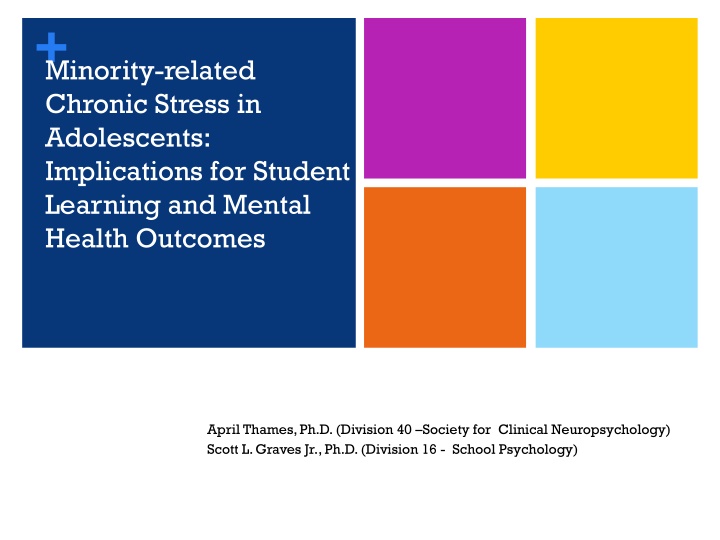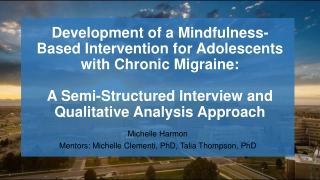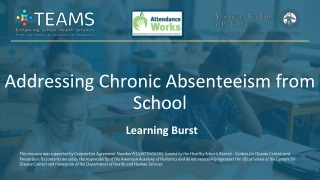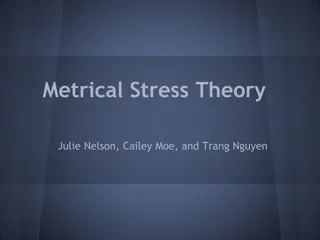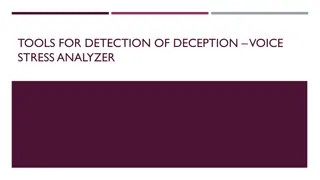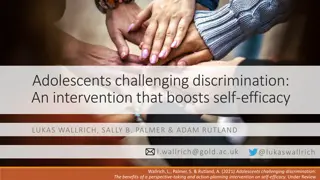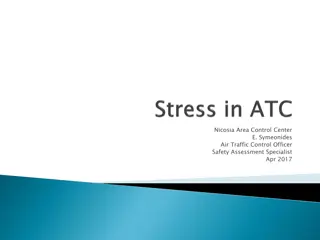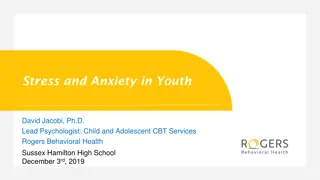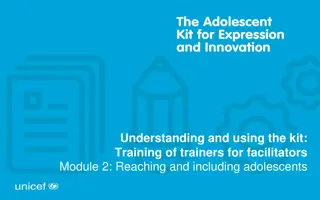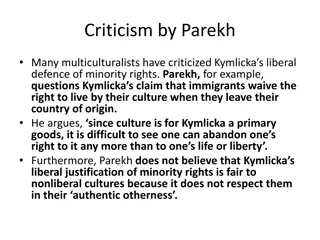+Minority-related Chronic Stress in Adolescents: Implications for Student Learning and Mental Health Outcomes
This research paper explores the impact of chronic stress on adolescents, focusing on its implications for student learning and mental health outcomes. Presented by April Thames, Ph.D., this study delves into the effects of minority-related stress on adolescents' well-being and academic performance.
Download Presentation

Please find below an Image/Link to download the presentation.
The content on the website is provided AS IS for your information and personal use only. It may not be sold, licensed, or shared on other websites without obtaining consent from the author.If you encounter any issues during the download, it is possible that the publisher has removed the file from their server.
You are allowed to download the files provided on this website for personal or commercial use, subject to the condition that they are used lawfully. All files are the property of their respective owners.
The content on the website is provided AS IS for your information and personal use only. It may not be sold, licensed, or shared on other websites without obtaining consent from the author.
E N D
Presentation Transcript
+ Minority-related Chronic Stress in Adolescents: Implications for Student Learning and Mental Health Outcomes April Thames, Ph.D. (Division 40 Society for Clinical Neuropsychology) Scott L. Graves Jr., Ph.D. (Division 16 - School Psychology)
+Race-related stress vs. stressors linked to race Race-related stress is defined as stress that is characterized by both social ostracism and blocked economic opportunity (Brondolo, Gallo, & Myers, 2009) (e.g., discrimination, racism) Race-related stress is a significant contributor in minority health disparities (Brondolo, Gallo, & Myers, 2009; Geronimus, Hicken, Keene, & Bound, 2006; Myers, 2009; Utsey & Hook, 2007). Stressors linked to racial identity are not synonymous with race-related stress Poverty Incarceration Food insecurity Neighborhood safety Interpersonal violence Family conflict
+Why Do Educators Need to Understand Chronic Stress One out of every 4 children attending school has been exposed to chronic and traumatic events that can affect learning and/or behavior These events can impact school performance (Lower GPA, higher absence rate, decreased reading ability, increased behavior problems) These events can impair learning. (Chronic exposure can adversely affect attention, memory, and cognition These children may experience physical and emotional distress
+Stress impacts neurodevelopment Early life stress can affect the developing brain in a way that leads to poorly controlled stress response systems (Loman & Gunnar, 2010). Overly reactive Slow to return to homeostasis Over time this can result in mental health problems and cognitive problems
+The Adolescent Brain During puberty there is a dramatic increase in neuron connectivity and growth throughout many parts of the brain During adolescence, many neural pathways will be pruned away because the pathways are not used Maturation and development of cognitive functioning and higher-level thinking skills
+The Adolescent Brain Heavy involvement of the limbic system (particularly the amygdala). Teenagers do more of their thinking and decision-making in this part of the brain. Greater need for proper nutrition, rest and sleep Its development depends largely upon the kinds and quality of experiences it receives. Sensitive to chronic stress Last part to mature part in which higher-level thinking and more rational decision-making occurs
+Stress Response Operates via two interrelated systems: SAM (Sympathetic-adrenomedullary) HPA (hypothalamic-pituitary-adrenocortical). These balance each other Both are triggered by the hypothalamus
+The brain system for appraising threats Limbic system: Adds emotional dimensions to stress perception: fear, anger, anxiety Especially centered in the hypothalamus
+Stress Response - Brain Prolonged exposure to adversity is associated with impairments in emotional regulation and learning and memory (Richards & Wadsworth, 2004; Shonkoff et al., 2012; Tottenham et al., 2010). Adverse events, and its resultant stress, engender such changes particularly in brain regions such as the hippocampus and amygdala (Lupien, McEwen, Gunnar & Heim, 2009; Sapolsky, 1996). Disruption of the HPA-axis has been associated with loss of neuronal connections and smaller hippocampal volume (Rao, Chen, Bidesi, Shad, Thomas & Hammen, 2010; Sapolsky, 1996; Woon & Hedges, 2008) and altered amygdala connectivity (Thomason, Marusak, Tocco, Vila, McGarragle & Rosenberg, 2015). Functional (Dannlowski et al., 2012; Hart & Rubia, 2012, McCrory et al., 2013; Teicher et al., 2002, 2010) Amygdala- hyper-responsivity (limbic irritability) Diminished right-left intrahemispheric communication Alterations in frontal-cingulate-limbic circuitry (Bluhm et al., 2009, Daniels et al., 2013, Dean et al., 2014, Krause et al., 2014, Phillip et al., 2013a, 2013b, van der Werff et al., 2013, Wang et al., 2014)
+Memory and learning in the teenage brain can be significantly affected by emotion Too much or too little will derail learning The brain is wired to pay attention first to sensory information that has a strong emotional content Strong emotional responses like anger, fear and intense anxiety can override conscious thought processing
Meta-analysis of school-based trauma interventions + Sareska Tamayo, Scott Graves & Research Group 14 studies met our criteria Effects PSTD (0.592) Depression (0.443) Anxiety (0.456) 13 in urban schools Mostly African American, Hispanic and Indian American children attending middle school Framework Cognitive Behavioral Therapy Interventions are responsive to multiple/cumulative trauma 10 sessions, mostly delivered in a group format
+Framework for Schools School wide infrastructure and culture Staff training Linking with Community Partners Academic instruction for traumatized children Nonacademic strategies
+ What can protect against the negative effects of stress?
+Teachers Role School staff should be trained regarding salient aspects of youth development, school climate, and the importance of positive adult-child relationships in promoting healthy and meaningful relationships Be a part of established routines (i.e. welcome students as they enter school each morning) Identifying a weekly school-wide topic (i.e. respect) and reinforcing this in a variety of ways to promote a positive school climate Teach children how to ask for help when needed Listen and model effective problem-solving skills
+Additional Strategies Provide unconditional regard in a safe and caring environment Always empower, never disempower Be assertive when addressing inappropriate conduct but avoid controlling methods o Set up situations for students to help themselves by helping others It can provide insight and lessen isolation o Maintain high expectations, routines and reasonable limits It sends message that student is worthy of continued love and attention o Increase connections with any pro-social person Embed instruction with both the effective and affective Check assumptions, observe and question. Teacher needs to model that life makes sense despite inevitable adversities. o
+Physical activity and movement greatly enhance learning for the teenage brain Regulates energy and attention levels in the brain and affects the release of hormones Can actually build brain cells Optimizes development of key areas of the brain Builds strong memory pathways Learners become more receptive to and engaged in the learning experience
+Supportive caregiving Children who receive supportive care appear to have reduced stress responses "that may buffer or protect the developing brain and result in a more stress-resilient child." (Gunnar & Quevedo, p 156) "Responsive caregiving allows children to elicit help by expressing negative emotions, without triggering the endocrine component of the stress response": plausibly a modified limbic system reaction.
+ Acknowledgments Special thanks to APA Committee on Division/APA Relations for their support in this project
